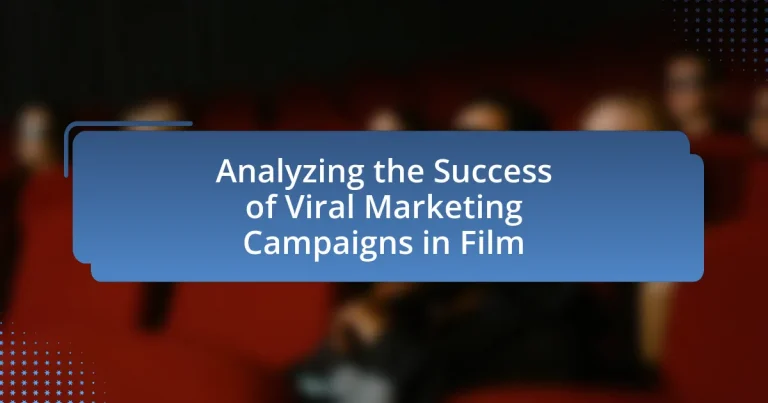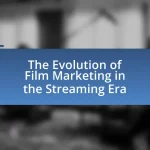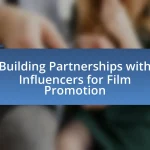Viral marketing campaigns in film are promotional strategies that generate widespread attention through social sharing and engagement, distinguishing themselves from traditional marketing methods by relying on organic audience interaction rather than paid advertising. Key elements contributing to the success of these campaigns include emotional appeal, shareability, and strategic timing, with social media playing a crucial role in amplifying reach and fostering community discussions. The article analyzes notable examples of successful viral marketing campaigns, such as “The Blair Witch Project” and “Deadpool,” while also exploring best practices, audience targeting, and metrics for measuring effectiveness. Additionally, it addresses the challenges and risks associated with viral marketing, providing insights into innovative techniques for enhancing audience engagement.
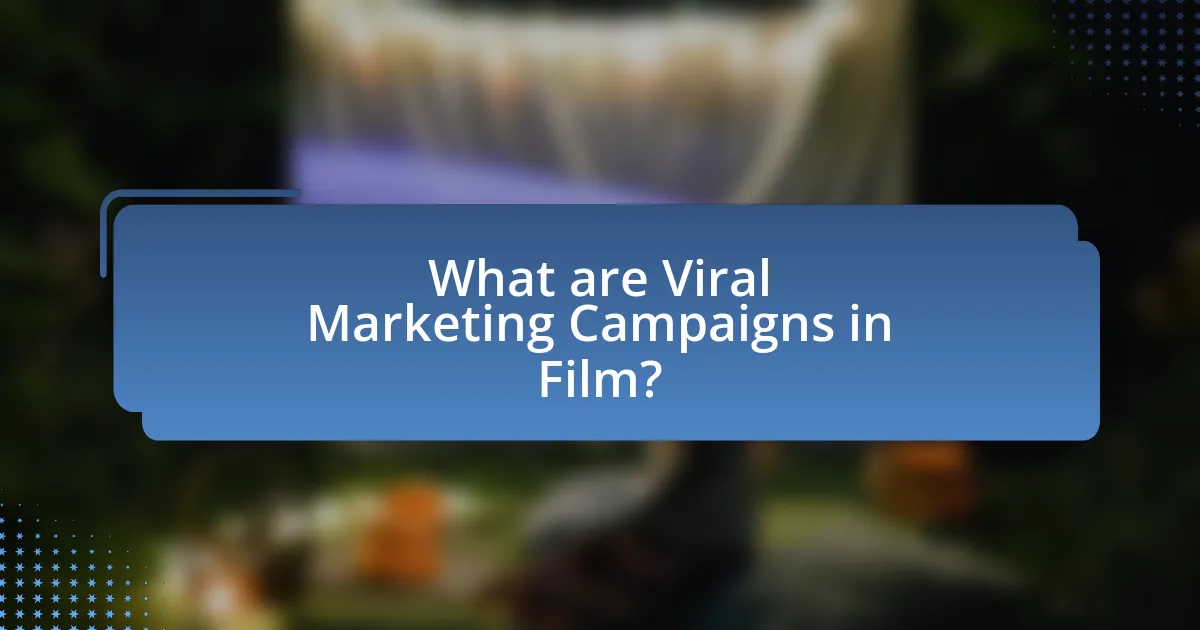
What are Viral Marketing Campaigns in Film?
Viral marketing campaigns in film are promotional strategies designed to create buzz and generate widespread attention through social sharing and engagement. These campaigns leverage social media platforms, user-generated content, and interactive experiences to encourage audiences to share information about a film, often leading to organic growth in viewership and interest. For example, the marketing campaign for the film “The Blair Witch Project” in 1999 utilized a website that presented the film as a real documentary, which sparked discussions and sharing among viewers, resulting in a box office success of nearly $250 million against a budget of only $60,000. This demonstrates how effective viral marketing can significantly enhance a film’s visibility and profitability.
How do viral marketing campaigns differ from traditional marketing strategies?
Viral marketing campaigns differ from traditional marketing strategies primarily in their reliance on organic sharing and user engagement rather than paid advertising. Traditional marketing often employs direct methods such as television ads, print media, and billboards, which target audiences through established channels. In contrast, viral marketing leverages social media platforms and user-generated content to encourage individuals to share the message, creating a ripple effect that can lead to exponential reach. For instance, a study by the Harvard Business Review found that viral campaigns can achieve a 10 to 100 times greater reach compared to traditional methods due to the power of social sharing. This difference highlights how viral marketing focuses on creating compelling content that resonates with audiences, prompting them to share it voluntarily, while traditional marketing relies on more controlled and less interactive approaches.
What elements contribute to the virality of a marketing campaign?
The elements that contribute to the virality of a marketing campaign include emotional appeal, shareability, and timing. Emotional appeal engages audiences by evoking strong feelings such as joy, surprise, or nostalgia, which can lead to increased sharing. Shareability is enhanced through relatable content, humor, or unique storytelling that encourages users to distribute the campaign across their networks. Timing is crucial; launching a campaign during relevant cultural moments or trends can significantly boost its visibility and engagement. For instance, the “Ice Bucket Challenge” effectively utilized emotional appeal and social media timing, resulting in over 17 million videos shared and raising $115 million for ALS research in just a few months.
Why is audience engagement crucial in viral marketing?
Audience engagement is crucial in viral marketing because it drives the spread of content through social sharing and interaction. Engaged audiences are more likely to share content with their networks, amplifying reach and visibility. According to a study by Nielsen, 92% of consumers trust recommendations from friends and family over any other form of advertising, highlighting the importance of audience-driven promotion. Additionally, higher engagement rates correlate with increased brand loyalty and customer retention, as seen in successful film marketing campaigns that leverage social media platforms to foster community interaction.
What role does social media play in viral marketing for films?
Social media serves as a crucial platform for viral marketing in films by enabling rapid content sharing and audience engagement. It allows filmmakers and studios to create buzz through trailers, behind-the-scenes footage, and interactive campaigns that encourage user participation. For instance, the marketing campaign for the film “It” in 2017 utilized social media platforms like Twitter and Instagram to share teaser content, resulting in over 1.5 million mentions and significant audience anticipation prior to its release. This demonstrates that social media not only amplifies reach but also fosters community discussions, which are essential for generating viral momentum.
How do platforms like Twitter and Instagram enhance campaign reach?
Platforms like Twitter and Instagram enhance campaign reach by leveraging their vast user bases and engagement features. Twitter’s real-time communication allows campaigns to trend through hashtags, enabling rapid dissemination of information to a wide audience. For instance, a study by Pew Research Center found that 22% of Twitter users engage with brands, amplifying campaign visibility. Instagram, with its visual-centric approach, facilitates sharing through stories and posts, which can lead to organic reach as users share content within their networks. According to Statista, Instagram has over 1 billion monthly active users, providing a substantial platform for campaigns to gain traction. Together, these platforms create opportunities for viral marketing by encouraging user interaction and content sharing, ultimately increasing campaign exposure.
What are the best practices for leveraging social media in film marketing?
The best practices for leveraging social media in film marketing include creating engaging content, utilizing targeted advertising, and fostering community interaction. Engaging content, such as behind-the-scenes footage, trailers, and interactive posts, captures audience attention and encourages sharing. Targeted advertising on platforms like Facebook and Instagram allows filmmakers to reach specific demographics, increasing the likelihood of attracting the right audience. Fostering community interaction through Q&A sessions, live events, and responding to fan comments builds a loyal fan base and enhances word-of-mouth promotion. According to a study by the American Film Institute, films that actively engage with audiences on social media see a 30% increase in box office revenue compared to those that do not.

What Factors Contribute to the Success of Viral Marketing Campaigns in Film?
The success of viral marketing campaigns in film is primarily driven by engaging content, strategic timing, and audience participation. Engaging content, such as intriguing trailers or shareable memes, captures attention and encourages sharing, which is essential for virality. Strategic timing, particularly aligning the campaign with key events or trends, maximizes visibility and relevance. Audience participation, facilitated through social media platforms, allows fans to create and share their own content, further amplifying the campaign’s reach. For instance, the “Blair Witch Project” utilized a compelling narrative and grassroots marketing, leading to a $248 million box office success from a $60,000 budget, demonstrating how these factors can effectively drive viral success.
How does audience targeting influence campaign success?
Audience targeting significantly influences campaign success by ensuring that marketing messages reach the most relevant and receptive groups. When campaigns are tailored to specific demographics, interests, and behaviors, they achieve higher engagement rates and conversion levels. For instance, a study by the American Marketing Association found that targeted campaigns can increase conversion rates by up to 50% compared to non-targeted efforts. This precision in targeting allows filmmakers to allocate resources more effectively, maximizing the impact of their marketing strategies and ultimately leading to greater box office success.
What demographics are most responsive to viral marketing in films?
Young adults aged 18 to 34 are the demographics most responsive to viral marketing in films. This age group is highly active on social media platforms, where viral marketing campaigns often gain traction. According to a study by the American Marketing Association, 70% of young adults report sharing film-related content online, indicating a strong propensity for engagement with viral marketing efforts. Additionally, this demographic tends to seek out peer recommendations and user-generated content, further amplifying the effectiveness of viral strategies in film promotion.
How can filmmakers identify and engage their target audience effectively?
Filmmakers can identify and engage their target audience effectively by utilizing data analytics and social media insights. By analyzing demographic data, viewing habits, and engagement metrics from platforms like Facebook, Instagram, and Twitter, filmmakers can pinpoint the preferences and behaviors of their potential audience. For instance, a study by the Pew Research Center indicates that 69% of adults in the U.S. use social media, providing filmmakers with a vast pool of data to understand audience interests and trends. Engaging this audience can be achieved through tailored marketing strategies, such as creating shareable content that resonates with their interests, thereby increasing the likelihood of viral engagement.
What metrics are used to measure the success of viral marketing campaigns?
The primary metrics used to measure the success of viral marketing campaigns include reach, engagement, conversion rate, and shareability. Reach quantifies the total number of individuals exposed to the campaign, while engagement measures interactions such as likes, comments, and shares, indicating audience interest. Conversion rate tracks the percentage of users who take a desired action, such as signing up or making a purchase, reflecting the campaign’s effectiveness in driving behavior. Shareability assesses how often content is shared across platforms, which is crucial for virality. These metrics collectively provide a comprehensive view of a campaign’s impact and effectiveness in achieving its goals.
How do views, shares, and engagement rates reflect campaign effectiveness?
Views, shares, and engagement rates are critical metrics that directly reflect the effectiveness of a marketing campaign. High view counts indicate that the content is reaching a broad audience, while shares demonstrate that viewers find the content valuable enough to distribute within their networks, amplifying its reach. Engagement rates, which include likes, comments, and interactions, provide insight into how well the audience connects with the content, suggesting that it resonates on a deeper level. For instance, a study by HubSpot found that campaigns with higher engagement rates typically see a 20% increase in conversion rates, validating the correlation between these metrics and overall campaign success.
What tools can be used to analyze the performance of viral campaigns?
Tools that can be used to analyze the performance of viral campaigns include Google Analytics, social media analytics platforms like Facebook Insights and Twitter Analytics, and specialized marketing tools such as BuzzSumo and Hootsuite. Google Analytics provides insights into website traffic and user behavior, allowing marketers to track the effectiveness of their campaigns. Social media analytics platforms offer metrics on engagement, reach, and audience demographics, which are crucial for understanding the impact of viral content. BuzzSumo helps identify trending content and measure social shares, while Hootsuite allows for monitoring and analyzing social media performance across multiple platforms. These tools collectively enable marketers to assess the success of their viral campaigns through data-driven insights.
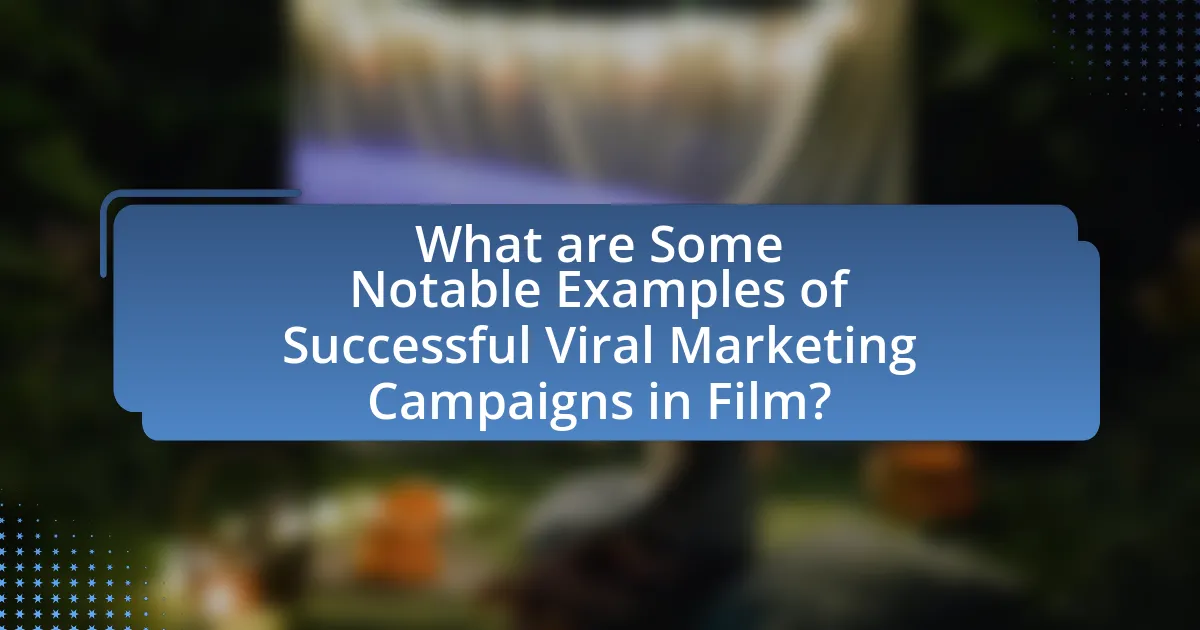
What are Some Notable Examples of Successful Viral Marketing Campaigns in Film?
Notable examples of successful viral marketing campaigns in film include the “Blair Witch Project,” “The Dark Knight,” and “Deadpool.” The “Blair Witch Project” utilized a grassroots approach, leveraging the internet to create a mythos around the film, resulting in a $248 million box office from a $60,000 budget. “The Dark Knight” employed a multi-platform strategy, including viral videos and interactive websites, which contributed to its $1 billion global gross. “Deadpool” famously used humor and social media engagement, including a viral marketing campaign that featured unconventional trailers and memes, leading to a $783 million box office from a $58 million budget. These campaigns demonstrate the effectiveness of innovative marketing strategies in generating audience interest and driving box office success.
How did specific films achieve viral success through marketing?
Specific films achieved viral success through innovative marketing strategies that engaged audiences and leveraged social media platforms. For instance, the marketing campaign for “The Blair Witch Project” utilized a grassroots approach, creating a website that presented the film as a real documentary, which generated buzz and intrigue. This strategy led to a box office return of nearly $250 million against a budget of only $60,000, demonstrating the effectiveness of viral marketing. Similarly, “Deadpool” employed a mix of humor and unconventional promotional tactics, including viral videos and social media engagement, which contributed to its $783 million global box office success. These examples illustrate how targeted marketing efforts can create significant audience engagement and drive film success.
What strategies were employed in the marketing of films like “The Blair Witch Project”?
The marketing strategies employed in the promotion of “The Blair Witch Project” included a groundbreaking use of viral marketing, which leveraged the internet and grassroots campaigns to create buzz. The filmmakers utilized a website that presented the film as a real documentary, featuring fake police reports and missing person flyers to enhance authenticity. This strategy effectively engaged audiences by blurring the lines between fiction and reality, leading to widespread discussion and speculation online. Additionally, the film’s limited budget necessitated a focus on word-of-mouth promotion, which proved successful as viewers shared their experiences and reactions, further amplifying interest. The combination of these tactics resulted in a highly effective marketing campaign that contributed to the film’s box office success, grossing nearly $250 million worldwide against a budget of only $60,000.
How did “Deadpool” utilize humor and audience interaction in its campaign?
“Deadpool” effectively utilized humor and audience interaction in its campaign by incorporating self-referential jokes, irreverent marketing materials, and engaging social media content. The film’s marketing team created a series of humorous trailers and promotional videos that showcased Deadpool’s unique personality, which resonated with audiences and generated significant buzz. For instance, the “Deadpool” Valentine’s Day campaign featured cheeky ads that played on romantic themes while maintaining the character’s signature humor. Additionally, the film’s social media presence encouraged fan interaction through witty posts and memes, fostering a sense of community among viewers. This approach not only entertained potential audiences but also encouraged them to share content, amplifying the campaign’s reach and effectiveness.
What lessons can be learned from these successful campaigns?
Successful campaigns in film marketing demonstrate the importance of audience engagement, strategic timing, and leveraging social media platforms. Engaging the audience through interactive content, such as behind-the-scenes footage or fan contests, fosters a sense of community and investment in the film. For instance, the “Blair Witch Project” utilized a grassroots marketing strategy that included a compelling website and viral word-of-mouth, leading to a box office success of nearly $250 million against a budget of $60,000. Additionally, timing the release of promotional content to coincide with key events or trends can amplify visibility and relevance, as seen with “Deadpool,” which capitalized on the superhero genre’s popularity. Lastly, utilizing social media effectively allows for real-time engagement and sharing, which can exponentially increase reach and impact, as evidenced by the “It” movie campaign that generated significant buzz through teaser trailers and interactive posts.
What common themes or strategies can be identified across successful campaigns?
Successful campaigns in film marketing often share common themes and strategies such as emotional engagement, storytelling, and leveraging social media. Emotional engagement captures audience attention and fosters a connection, as seen in campaigns like “The Pursuit of Happyness,” which resonated with viewers through its inspirational narrative. Storytelling creates a compelling narrative that draws audiences in, exemplified by the “Star Wars” franchise, which builds anticipation through rich lore and character development. Additionally, leveraging social media platforms enhances reach and interaction; for instance, the “Deadpool” campaign utilized humor and viral content on platforms like Twitter and Instagram to engage fans directly, resulting in significant box office success. These strategies collectively contribute to the effectiveness of viral marketing campaigns in the film industry.
How can filmmakers apply these lessons to future projects?
Filmmakers can apply lessons from successful viral marketing campaigns to future projects by integrating audience engagement strategies that foster community involvement and sharing. For instance, utilizing social media platforms to create interactive content can enhance viewer participation, as seen in the marketing of films like “The Blair Witch Project,” which effectively used online forums to build anticipation and buzz. Additionally, filmmakers should analyze data from past campaigns to identify which elements resonated most with audiences, allowing for targeted marketing efforts that align with viewer preferences. This approach is supported by research indicating that campaigns leveraging user-generated content can increase engagement rates by up to 28%. By implementing these strategies, filmmakers can create more impactful marketing campaigns that drive interest and viewership for their films.
What are the challenges faced in executing viral marketing campaigns?
Executing viral marketing campaigns presents several challenges, including unpredictability, audience targeting, and content saturation. The unpredictability of viral content makes it difficult for marketers to anticipate what will resonate with audiences, as factors like timing and cultural relevance play significant roles. Additionally, accurately targeting the right audience is crucial; failing to do so can result in low engagement and wasted resources. Content saturation is another challenge, as consumers are bombarded with marketing messages, making it harder for any single campaign to stand out. According to a study by the Harvard Business Review, only 1 in 1,000 marketing campaigns achieves viral status, highlighting the inherent difficulties in creating successful viral marketing strategies.
How can negative feedback impact a viral marketing strategy?
Negative feedback can significantly undermine a viral marketing strategy by damaging brand reputation and reducing audience engagement. When consumers express dissatisfaction, it can lead to a negative perception of the brand, which may deter potential customers from participating in the campaign. For instance, a study by the Harvard Business Review found that negative online reviews can decrease sales by 22% for a product. Additionally, negative feedback can spread rapidly through social media, amplifying its impact and potentially overshadowing positive messages. This creates a challenging environment for marketers, as they must address the negative sentiments while trying to maintain the campaign’s momentum.
What risks are associated with relying on viral marketing for film promotion?
Relying on viral marketing for film promotion carries several risks, including lack of control over the message, potential for negative backlash, and unpredictability of audience engagement. The lack of control means that once content is released, it can be altered or misinterpreted by users, leading to unintended consequences. For instance, the 2016 film “Ghostbusters” faced significant backlash due to its marketing campaign, which was perceived as divisive, ultimately affecting its box office performance. Additionally, viral campaigns can generate negative attention; if the content is poorly received, it can harm the film’s reputation. Lastly, the unpredictability of audience engagement means that even well-crafted viral content may not resonate, leading to wasted resources and missed opportunities.
What are the best practices for creating a successful viral marketing campaign in film?
The best practices for creating a successful viral marketing campaign in film include leveraging social media platforms, engaging influencers, and creating shareable content. Social media platforms like Facebook, Twitter, and Instagram are essential for reaching a wide audience quickly; for instance, the “Blair Witch Project” utilized online forums to generate buzz before its release, resulting in a $248 million box office from a $60,000 budget. Engaging influencers can amplify reach; campaigns that involve popular figures often see increased engagement, as demonstrated by the “Deadpool” campaign, which featured Ryan Reynolds actively promoting the film. Additionally, creating shareable content, such as memes or interactive experiences, encourages audience participation and sharing, which is crucial for virality. For example, the “It” movie campaign included a series of engaging teasers that sparked conversations online, leading to significant audience anticipation and ticket sales.
How can filmmakers effectively plan and execute a viral marketing strategy?
Filmmakers can effectively plan and execute a viral marketing strategy by leveraging social media platforms, creating engaging content, and utilizing influencers to amplify their message. Social media platforms like Instagram, TikTok, and Twitter allow filmmakers to reach a broad audience quickly; for instance, the film “It Follows” utilized social media teasers that generated significant buzz prior to its release. Engaging content, such as behind-the-scenes footage or interactive challenges, encourages audience participation and sharing, as seen with the “Blair Witch Project,” which relied heavily on user-generated content to create intrigue. Additionally, collaborating with influencers who resonate with the target demographic can enhance credibility and reach, exemplified by the marketing strategy of “Deadpool,” which involved partnerships with popular social media personalities to promote the film. These methods, when combined, create a cohesive and compelling viral marketing strategy that can significantly increase audience engagement and anticipation.
What innovative techniques can be used to enhance audience engagement?
Innovative techniques to enhance audience engagement include interactive storytelling, gamification, and personalized content delivery. Interactive storytelling allows audiences to influence the narrative, creating a more immersive experience; for example, films like “Bandersnatch” from the “Black Mirror” series have successfully utilized this technique. Gamification incorporates game-like elements, such as challenges and rewards, to motivate audience participation, as seen in campaigns for movies like “The Hunger Games,” which engaged fans through interactive online experiences. Personalized content delivery leverages data analytics to tailor marketing messages to individual preferences, significantly increasing engagement rates; research indicates that personalized emails can lead to a 29% increase in open rates and a 41% increase in click-through rates.
